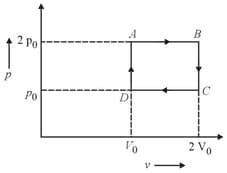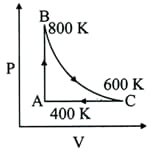The shown diagram represents the thermodynamic cycle of an engine, operating with an ideal mono atomic gas. The amount of heat, extracted from the source in a single cycle is



Important Questions on Thermodynamics
One mole of diatomic ideal gas undergoes a cyclic process as shown in the figure. The process is adiabatic. The temperatures at and are and , respectively. Choose the correct statement.

A solid body of constant heat capacity is being heated by keeping it in contact with reservoirs in two ways
(i) Sequentially keeping in contact with reservoirs such that each reservoir supplies the same amount of heat.
(ii) Sequentially keeping in contact with reservoirs such that each reservoir supplies the same amount of heat.
In both the cases, the body is brought from initial temperature to final temperature . Entropy change of the body in the two cases respectively, is
of helium gas at S.T.P. is adiabatically compressed to . Taking the initial temperature to be the work done in the process is,
Two moles of ideal helium gas are in a rubber balloon at The balloon is fully expandable and can be assumed to require no energy in its expansion. The temperature of the gas in the balloon is slowly changed to The amount of heat required in raising the temperature is nearly
